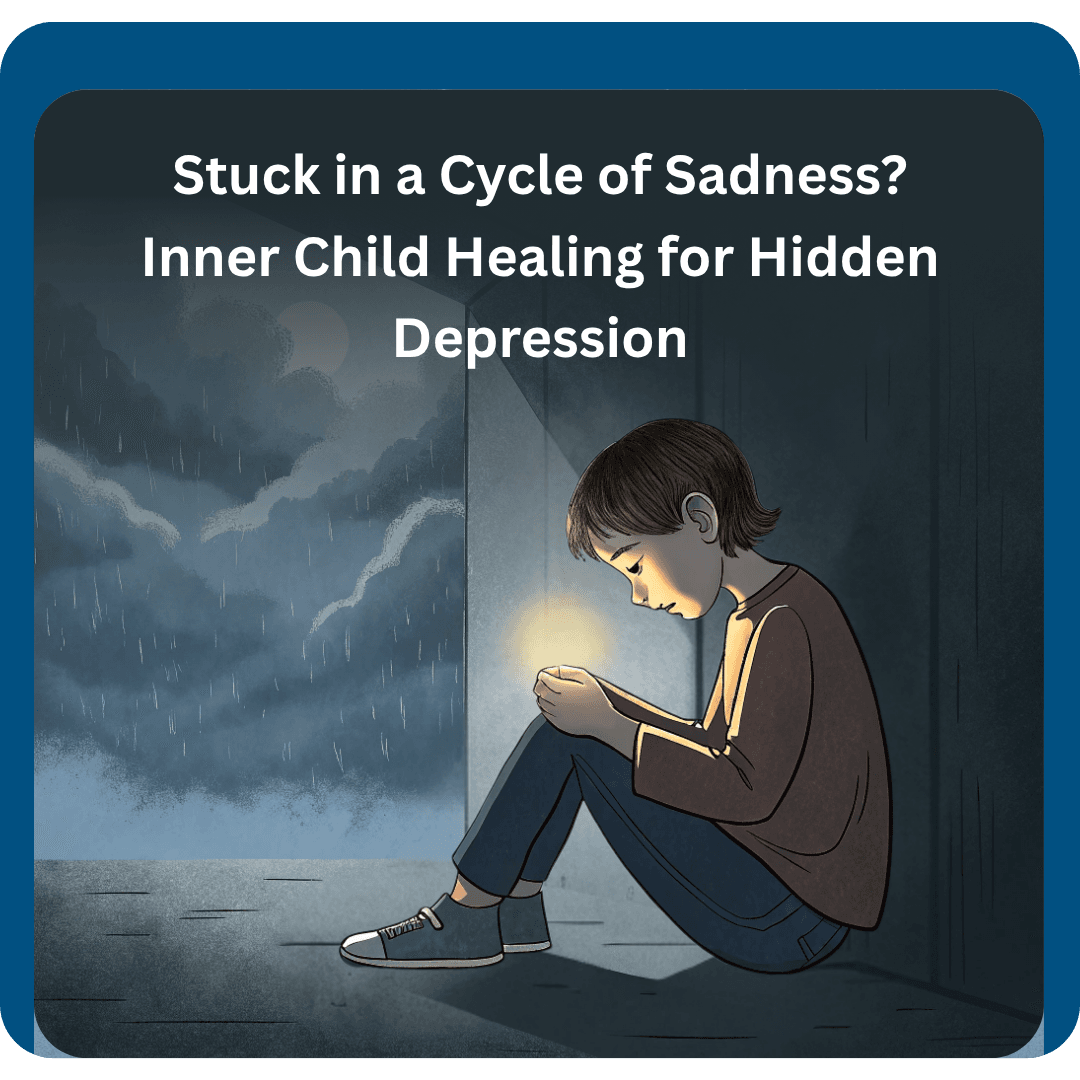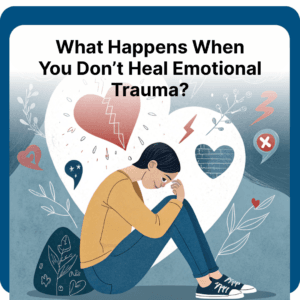Stuck in a Cycle of Sadness? Inner Child Healing for Hidden Depression
Table of Contents
What Is Inner Child Healing? A Path to Emotional Clarity
Inner child healing is a therapeutic process that reconnects you with the younger version of yourself—the part that first experienced fear, abandonment, shame, or rejection. This part of you never really left. She (or he) still influences how you love, trust, cope, and express yourself today.
This practice doesn’t just focus on memories—it focuses on the emotional patterns and beliefs that were born in childhood and silently run the show in adulthood. Patterns like:
- “I have to make everyone happy.”
- “If I rest, I’m lazy.”
- “I’m too much or not enough.”
By reconnecting with your inner child, you begin to hear what she’s been trying to say for years: “See me. Love me. Let me be safe.”
The Silent Struggle of Hidden Depression
Ashima was the kind of person everyone admired. Always cheerful, highly productive, and the go-to for emotional advice. But every evening, when the world quieted down, Ashima felt an invisible weight sink into her chest. She didn’t cry. She wasn’t suicidal. But she wasn’t okay either.
There were days she’d lie on her bed staring at the ceiling, wondering why nothing brought her joy anymore.
“I have everything to be happy about, but I’m just… not,” she confessed in a therapy session.
What Ashima was experiencing is known as hidden depression—a form of emotional exhaustion that often goes unnoticed because it wears a mask of functionality. The root of this sadness? Often, it lives quietly in our childhood memories, unmet needs, and emotional wounds.
This is where inner healing becomes a powerful path toward lightness, clarity, and lasting peace.
Understanding Inner Child Wounds and Their Impact on Adult Emotions
Let’s take Neha’s story. She was a successful marketing lead, thriving professionally, but struggled with feeling emotionally numb in her relationships. In her session, she remembered being scolded for “crying too much” as a child.
Her subconscious takeaway? “My feelings are a burden.”
This core wound became the blueprint for her adult life—she avoided emotional vulnerability, suppressed sadness, and disconnected from herself.
Common inner child wounds include:
- Abandonment: Feeling neglected or emotionally disconnected from caregivers.
- Shame: Being told you’re “too sensitive,” “too loud,” or “too needy.”
- Rejection: Not feeling accepted for who you are.
- Control: Growing up in chaotic homes where safety meant compliance.
These wounds create emotional defense mechanisms like people-pleasing, perfectionism, or chronic sadness—classic signs of hidden depression.
The Different Inner Child Types: Which One Are You Carrying?
Not all inner children are the same. Here are four common inner child archetypes:
- The Abandoned Child: Deep fear of rejection, always seeks reassurance in relationships.
- The Pleaser Child: Overextends herself to avoid conflict or gain love.
- The Perfect Child: Believes love must be earned through achievement.
- The Wild Child: Feels unseen and misunderstood, often rebels or isolates.
Recognizing which type you carry helps you meet your inner child where she is—and offer the nurturing she never received.
How Inner Child Work Uncovers the Roots of Hidden Depression
Hidden depression doesn’t always come from big trauma. Sometimes, it’s the accumulation of little moments: not being hugged when you cried, being told to “grow up,” or being ignored when you were scared.
Over time, we learn to disconnect from our feelings for survival. That disconnection becomes a form of silent suffering—what we now call high-functioning or hidden depression.
Inner child therapy invites us to:
- Acknowledge buried emotions without judgment
- Offer love and safety to our younger self
- Rewire beliefs formed in childhood
- Reclaim the parts of ourselves we silenced
When Ashima finally told her inner healing, “You don’t need to earn love by being perfect,” she wept. That was the moment her healing truly began.
Inner Child Meditation: A Gentle Way to Reconnect and Heal
One powerful technique is inner child meditation—a guided process that helps you meet your younger self in a safe, loving mental space.
In this practice, you:
- Close your eyes and visualize your childhood self.
- Observe how she feels—scared, lonely, playful, or angry.
- Speak gently to her. Say the words she never heard.
- Ask: “What do you need from me right now?”
Even five minutes of this daily can lead to emotional shifts and deep self-awareness. It creates a bridge between who you were and who you’re becoming.
Signs You’re Ready for Inner Child Therapy
Wondering if this work is right for you? You may be ready for inner child healing if:
- You feel stuck in recurring emotional patterns.
- You’re highly sensitive and easily overwhelmed.
- You struggle with self-worth despite your achievements.
- You crave connection but push people away.
- You feel a lingering sadness or numbness.
Inner child work doesn’t mean something is “wrong” with you. It simply means you’re ready to remember the parts of yourself you had to abandon to survive.
Final Thoughts: You’re Not Broken — You’re Becoming Whole
That lingering sadness you feel? It isn’t weakness. It’s a signal—a whisper from the past asking to be heard, held, and healed.
Your inner child doesn’t want to be “fixed.”
She wants to be loved, witnessed, and set free.
And when is she?
You stop operating from wounds… and start living from wholeness.
If you’re tired of pretending to be okay, tired of hiding behind smiles and to-do lists, maybe it’s time to meet the little girl inside who’s been waiting for you all along.
“I didn’t find answers,” Ashima said after her third session.
“I found myself. And that made all the difference.”
✨ Ready to explore inner child healing? Visit www.sonalimittra.com to book a 1:1 session and begin your journey home to yourself.
Yes, absolutely. You don’t need clear or detailed memories. Emotional patterns, body responses, and feelings often guide the healing, even with vague memories.
It varies. Some people feel emotional relief or clarity after just a few sessions; for others, it takes weeks or months. Consistency is more important than speed.
No. Even without big traumas, unmet emotional needs, neglect, or internalized beliefs from childhood can cause sadness, low self-worth, or recurring patterns.
Yes, you can start with journaling, meditation, or self-guided inner child exercises. But deeper healing, especially around hidden depression, works best with a trained therapist or healer.
The inner child can be any developmental age—infant, toddler, school-age, teenager. Sometimes there are multiple inner children holding different emotional wounds.
Examples: “I have to make everyone happy,” feeling unworthy, avoiding emotional vulnerability, perfectionism, suppressing feelings.
If you feel stuck in emotional patterns, easily overwhelmed, struggle with low self-worth, feel disconnected, or have lingering sadness or numbness, you may be ready.
Sometimes yes, through guided reflection or visualization. But it doesn’t require force-feeding painful memories; healing can occur by addressing beliefs and emotions in safe ways.
Yes. By reconnecting with unmet needs, healing suppressed shame or fear, and changing old beliefs, inner child work helps lighten the emotional load and bring clarity.
Simple practices: short daily meditations, journaling, speaking kindly to yourself, setting boundaries, noticing triggers and responding with compassion rather than judgment.




This blog on inner child healing really spoke to me. It’s so true how hidden depression often comes from old wounds we never addressed. Thank you for reminding us to be gentle with that younger version of ourselves.